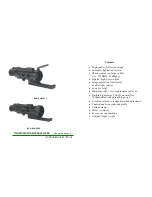
20
I
ENGLISH
1 If you feel any resistance while turning a screw, stop immediately and loosen the two screws on either side of the one you
are turning
2 Only make small adjustments to each screw; turning them only ¼ turn at a time
3 If your telescope appears collimated after star testing, it should not need adjustment again unless it is roughly handled
TIPS FOR COLLIMATION
A collimated telescope should appear symmetrical with the
central obstruction centered in the star’s diffraction pattern.
Perfect collimation will yield a star image very symmetrical
just inside and outside of focus In addition, perfect collimation
delivers the optimal optical performance specifications
that your telescope is built to achieve
If seeing (i e , air steadiness) is turbulent, collimation is difficult
to judge Wait until a better night if it is turbulent or aim to a
steadier part of the sky Stars in a steady part of the sky will
be still, not twinkling
3 Locate the collimation screw closest to where your finger is positioned This will be the collimation screw you will need to
adjust first (If your finger is positioned exactly between two of the collimation screws, then you will need to adjust the screw
opposite where your finger is located)
4 Use the hand control buttons to move the de-focused star image to the edge of the field of view in the same direction that
the central obstruction of the star image is skewed
5 While looking through the eyepiece, use a Phillips head screw driver to turn the collimation screw you located in step 2 and
3 Usually a tenth of a turn is enough to notice a change in collimation If the star image moves out of the field of view in
the direction that the central shadow is skewed, than you are turning the collimation screw the wrong way Turn the screw in
the opposite direction, so that the star image is moving towards the center of the field of view
6 If, while turning, you notice that the screws get very loose, then simply tighten the other two screws by the same amount
Conversely, if the collimation screw gets too tight, then loosen the other two screws by the same amount
7 Once the star image is in the center of the field of view, check to see if the rings are concentric If the central obstruction is
still skewed in the same direction, then continue turning the screw(s) in the same direction If you find that the ring pattern
is skewed in a different direction, simply repeat steps 2 through 6 as described above for the new direction
Summary of Contents for 22084
Page 2: ...2 I ENGLISH ...
Page 4: ...4 I ENGLISH ...
Page 24: ......
Page 26: ...2 I FRANÇAIS ...
Page 28: ...4 I FRANÇAIS ...
Page 48: ......
Page 50: ...2 I DEUTSCH ...
Page 52: ...4 I DEUTSCH ...
Page 72: ......
Page 74: ...2 I ESPAÑOL ...
Page 76: ...4 I ESPAÑOL ...
Page 96: ......
Page 98: ...2 I ITALIANO ...
Page 100: ...4 I ITALIANO ...
Page 120: ......
















































